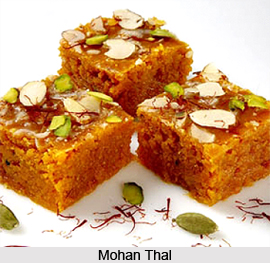 Mohan Thal is a sweet recipe made from roasted gram flour, ghee and other ingredients. It is mostly popular during auspicious occasions like Diwali in Western Indian states like Maharashtra and Gujarat and Goa. Mohan Thal is easy to make and is considered as Lord Krishna"s favourite sweet.
Mohan Thal is a sweet recipe made from roasted gram flour, ghee and other ingredients. It is mostly popular during auspicious occasions like Diwali in Western Indian states like Maharashtra and Gujarat and Goa. Mohan Thal is easy to make and is considered as Lord Krishna"s favourite sweet.
Ingredients
For Gram Crumbs
•250gms. gram flour
•1 tbsp. ghee
•3 tbsp. milk
•Mava (khoya)
•50 ms. khoya
To Proceed
•3/4 cup curds
•200gms. sugar
•1/2 tsp. cardamom powder
•1/5 tsp. crushed saffron
•150 gms. pure ghee
To Garnish
Silver foil or crushed almonds and pista mixed.
For Crumbs
•Rub in flour, ghee and milk.
•Press down with palm, keep aside 5 minutes.
•Pass mixture through a large holed sieve.
•Crumbs should form. Keep aside.
For Mava
Put khoya in a heavy saucepan, cook till crumbly. Stir continuously. Keep aside.
Made Syrup Simultaneously
•Put sugar and 2/3 ratio water, boil to 2 1/2 thread syrup.
•Add saffron soaked and rubbed in 2 tsp. water. Bring back to 2 1/2 thread consistency.
To Proceed Simultaneously with Syrup
•Put ghee in large pan, add crumbs. Stir and roast till aroma exudes and is golden.
•Add curd and stir gradually.
•Add mava, cardamom, and mix well. Remove from fire.
•Add syrup and mix well gradually. Do not stir too vigorously, or it will turn hard.
•Pour into a greased thali.
•Tap lightly and shake gently to spread. Allow to cool slightly.
•Apply silver foil or sprinkle crushed nuts.
•Cool.
•Cut into squares.
•Store in airtight container.
Preparing Mohan Thal with Besan
Following is another recipe for preparing mohan thal and is very popular among people with a sweet tooth.
Ingredients
•400 gms condensed milk
•3 cups besan (Bengal gram flour)
•2 tbsp milk
•A few saffron (kesar) strands
•1 cup ghee
•Chopped almonds (badam) and pistachios for garnishing
Preparation Method
•Combine milk and besan and mix well and keep aside for 30 minutes.
•Heat ghee in a pan, add the besan and saute for 12 minutes.
•Add the condensed milk and cook with while stirring continuously for 15 minutes or till the mixture thickens.
•Add the saffron, mix well and remove from the flame and pour the mixture into a greased plate and garnish with almonds.
•Cool and cut into desired pieces.




















